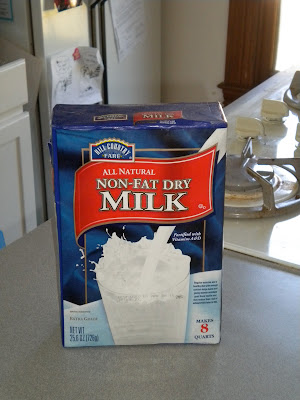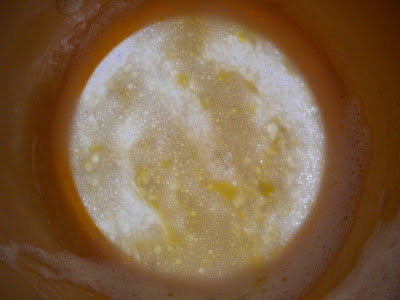“I can't go to taco bell, I'm on an all-carb diet. *God* Karen, you're so stupid!”
-- Regina
Custard at its most basic is eggs and milk. If you’re making dessert custard then you have to bring in some sugar. That’s all it takes to make something velvety and wonderful. Except, not really. Even if the only ingredients were eggs, milk, and sugar, I could write a whole book on exactly what to do with those base materials.
Flan takes things a step further and brings in my culinary nemesis: caramelized sugar. How many pots of crystallized or burnt sugar have lost their lives in my drive to make a toasty sugar syrup? It’s taken me dozens of attempts to figure out the appropriate technique, but melting sugar is clearly a skill that only comes with practice.
This time I’m using an excellent recipe from Rick Bayless. I’m sure it’s perfect made exactly as he specifies, but I’ll never know. I can never make this recipe without feeling compelled to change it; I'll discuss some of those alternations below. Needless to say, this post will be filled with stories about incredibly stupid custard shortcuts I've taken over the years. Don't follow in my footsteps.
It’s not made obvious unless you read through the recipe before starting, but you need to make the caramel first, especially if you cut corners like I do. Dump the sugar in a pot and add water. I used a candy thermometer because it's easier to tell when you’ve crept into burnt sugar temperatures. Bring the liquid to a boil, drop the heat, and don’t touch the damn thing. You have no idea what a challenge this is for me. Sometimes I have to verbally bully myself out of the kitchen. Neuroticism is fun.
Look at that sugar lump! It’s begging to be stirred into a homogeneous mass. But I promise you that just dipping a spoon into this bubbling mess guarantees a crystallized sludge. Don’t swirl the pan. Don’t tilt the pan. Don’t look too firmly at the pan. It’s going to take time, maybe fifteen minutes. And at some point this will start happening:
Do you have any idea how hard it is to photograph sugar bubbles? I had to cram the camera into that steaming pot and try to capture a rolling boil without blurring or losing focus and also not getting melted sugar on my hands. (That’s an important point; melted sugar is lava. If you get this stuff on you, expect nasty blisters and maybe even scarring. Unlike boiling water, it retains heat. And it sticks to your skin. And it has to be vigorously scrubbed off.)
Anyway, that’s a photo of small, flat sugar crystals forming on top of the bubbles. Every fiber of my being wants to take a spoon and stir those crystals until they dissolve. This is the point of caramel making where I need to distract myself. That makes it an excellent time to prepare the water bath.
Baked custard needs to be surrounded by boiling water. There are three key words there: surrounded, boiling, and water. I’ve at some point tried to cut corners on each. Learn from my mistakes.
First, surrounded. You must use a container as deep or deeper than your custard dishes. You must have enough water to reach over halfway up the custard dishes. You must put a cloth on the bottom of your larger container. That cloth serves two important functions. Your custard dishes won’t slide around, and water will seep through the cloth and under the custard dishes. This ensures the water bath surrounds all sides of the custard. As I once did, you might ask, “Why does the water have to surround the entire dish?” The water is not there to provide steam (though I’m sure that helps the baking); it ensures very even distribution of heat into the baking custard. If you don’t surround the dishes in water, you shouldn't bother adding water at all.
Second, boiling. It’s so easy to skip this step; who can remember to put a kettle on in the midst of candy making? For the love of God don’t skip this step. The whole point of the water is, as I previously stated, even distribution of heat. If you put cold water in a hot oven, the top of the custard will cook while the water is heating up. Then it’s too late, and the custard will be rubbery. Or just tough and brown on top. This is worse because it’s impossible to tell when the damn things are done if the tops aren’t soft. So you end up overcooking or undercooking the whole thing. Boil the water.
Third, water. “Gee,” I once said. “Wouldn’t it be easier if I just did away with the water bath? What harm could that do?” Idiot. Let’s just say the custard was thrown out. Rather, it was chiseled and scraped into the trash. If you don’t want to bother with a water bath, make pudding.
Water bath ready, I turned back to my caramel. There are no pictures of these next steps because I tend to panic with burning sugar and I don’t have the skills to pour lava/melted sugar with one hand while taking sexy food photos with the other. What you’re looking for is an amber color. Once that happens you start swirling the pan until you get the color you want, a really dark brown. The caramel is going to look much darker in the pan than it will in the custard dish. And if you panic, like I did, you’ll pour the syrup too soon and end up with a super light caramel.
That’s me holding the dish up to the light. Until you can smell burnt sugar, you probably haven’t gone far enough. I got nervous and ended up with a caramel sauce with no caramel flavor. Don’t be that person.
Once you’ve got the color you want, you have to move quickly. Pour the liquid in each of the dishes you’re using and give each a quick swirl. A few seconds hesitation and you’ll fail; the candy hardens almost immediately.
Speaking of which, good luck cleaning the stovetop.
Now, assembling the custard itself should be straight forward. You just need to simmer milk for the next hour and a half –
What the hell was that? Powdered milk? Isn’t that a flavorless bastardization of everything milk stands for? Yes, yes it is… except in this instance. Sure, you could spend your afternoon hovering over a simmering pot of milk and sugar, scraping the bottom and fighting a losing battle against milk’s tendency to form a skin, or you could make a double strong batch of powdered milk. I know there’s someone in your family who insists [nasty store brand] tastes just as good as [the real thing], and they’re lying to your face. However, powdered milk, cooked with sugar and eggs, tastes exactly like regular milk, and I actually prefer it because it makes smoother custard. Even straining twice, I can never get all the little bits of burnt or congealed milk, and those become unpleasant granules in the final product. Ironic since powdered milk starts as unpleasant granules.
See. You’re looking at one and a half hours in powder form.
You may have noticed that all my previous mistakes with custard stem from a desire to cut corners. So you think I’d have learned, but no. This time I decided to skip the "boil the milk and temper the eggs" step. Don’t do that. Unless you like your flan to be… crumbly I guess. The texture defied description. However, having made this flan several times without skipping the tempering step, I can swear that it makes the silkiest flan I’ve ever had.
Ten eggs. Do not skimp on the yolks. If you can find really huge eggs, use them. That makes me wish I lived near an ostrich farm…
So you’ve tempered your eggs and added vanilla. It all looks nice and smooth so you’re going to skip the straining step. Enjoy eating those scrambled eggs. Strain. Strain twice. If I could get my hands on cheesecloth I’d use that too. You can’t strain too much. I mean, just look at that thing. Ugh.
When you put the flan in the oven, plan your insertion better than I do. Put the water bath in the oven, pour the custard in the dishes, and then pour the boiling water. This greatly reduces the possibility of third-degree burns. Put foil over the whole thing; you don’t have to wrap it tight, just rest it over the dishes.
I have no idea where all these pots come from. I think my sister, who does the dishes, has an aneurysm every time I mention making flan.
Use your judgment for when the flan is done. Each custard should be very light in color, and will jiggle when shaken. Don’t worry if they seem a little underdone. Custard cooks for some time after you pull it out of the oven, and if the flan is done in the oven you either eat it boiling hot or cold and overcooked.
I love this recipe. I've just never learn to leave it alone. Don’t be like me; follow the instructions and you’ll be fine. And invite someone over who will do the dishes.














No comments:
Post a Comment